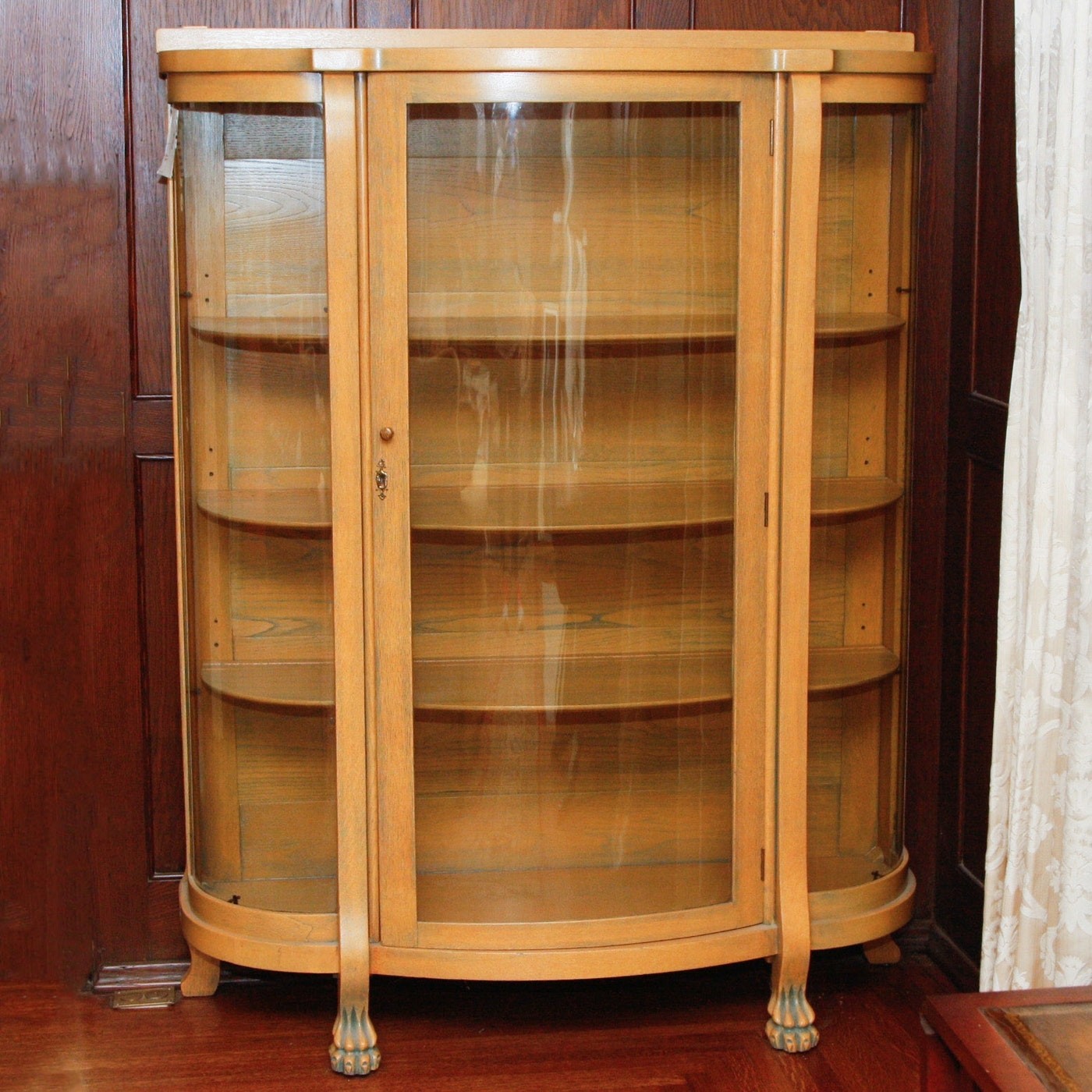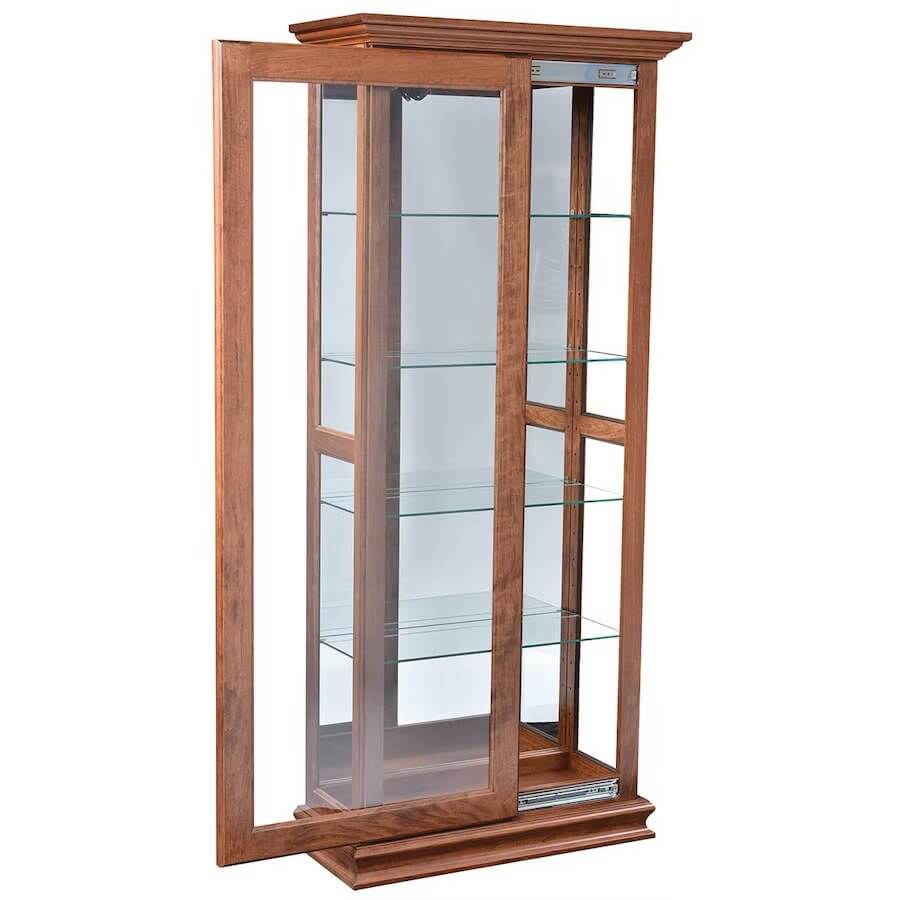History and Evolution of Bow Front Curio Cabinets

Bow front curio cabinets, with their graceful curves and intricate details, have a rich history that spans centuries, reflecting evolving tastes and technological advancements. These cabinets, designed to showcase prized possessions, have evolved from simple storage solutions to sophisticated statements of style and craftsmanship.
Origins and Early Evolution
Bow front curio cabinets trace their roots back to the 17th century, emerging from the evolving design trends of the Renaissance and Baroque periods. Initially, these cabinets were primarily functional pieces, serving as storage for valuable items like porcelain, silverware, and books. The curved front, often referred to as a “bow” or “belly,” provided a larger display area and a more elegant visual appeal than traditional rectangular cabinets.
- Early Examples: The earliest bow front curio cabinets were typically constructed from wood, often oak or walnut, and featured simple, understated designs. They were often decorated with carved moldings and sometimes adorned with brass hardware.
- Influence of Baroque Style: As the Baroque period gained momentum, bow front curio cabinets became more ornate and elaborate. They incorporated decorative elements like scrollwork, gilded accents, and intricate marquetry. The use of exotic woods, such as mahogany and rosewood, became increasingly popular, adding to the luxurious appeal of these cabinets.
The 18th and 19th Centuries: Refinement and Innovation
During the 18th and 19th centuries, bow front curio cabinets continued to evolve, incorporating new materials and design styles. The Rococo period, with its emphasis on lightness and elegance, saw the introduction of delicate curves and flowing lines. The Neoclassical period, with its focus on symmetry and proportion, led to the development of more restrained and geometric designs.
- Materials and Techniques: The use of glass in cabinet doors became increasingly common, allowing for better visibility of the displayed items. New techniques, such as veneering and inlay, were developed, allowing for greater detail and sophistication in the cabinets’ designs.
- Notable Examples: Some notable examples of bow front curio cabinets from this period include the Chippendale-style cabinets, known for their intricate carvings and elegant proportions, and the Sheraton-style cabinets, characterized by their simple lines and delicate ornamentation.
The 20th Century and Beyond: Modern Interpretations
In the 20th century, bow front curio cabinets continued to be popular, with designers reinterpreting traditional styles and incorporating modern materials. The Art Deco movement, with its geometric patterns and bold colors, influenced the design of some cabinets. Contemporary designers have created modern interpretations of bow front curio cabinets, often using materials like metal, glass, and acrylic to achieve a sleek and minimalist aesthetic.
- Contemporary Styles: Modern bow front curio cabinets often feature clean lines, simple shapes, and minimal ornamentation. They are often designed to complement modern interiors, incorporating materials like stainless steel, tempered glass, and high-gloss finishes.
- Functionality and Display: Contemporary designs often incorporate features like LED lighting, adjustable shelves, and lockable doors to enhance functionality and display capabilities. These features allow for the safe and stylish presentation of valuable collectibles, artwork, and other prized possessions.
Design Elements and Features of Bow Front Curio Cabinets: Antique Bow Front Curio Cabinet

The captivating charm of bow front curio cabinets lies in their distinctive design, a harmonious blend of functionality and aesthetic appeal. These cabinets, with their curved fronts and intricate details, have graced homes for centuries, serving as both elegant display cases and valuable storage solutions.
Curved Front and Glass Doors
The defining characteristic of a bow front curio cabinet is its curved front, often described as a “bow” or “arch.” This distinctive feature creates a sense of elegance and sophistication, adding a touch of grandeur to any room. The curved front is typically made of wood, meticulously crafted to achieve the desired shape. The glass doors, usually made of clear or frosted glass, provide a clear view of the treasures displayed within. These doors often feature intricate detailing, such as beveled edges, etched patterns, or ornate hardware.
Materials Used in Construction
Bow front curio cabinets are typically constructed from a variety of materials, each contributing to their durability, beauty, and overall appeal.
- Wood: The most common material used for the cabinet’s frame and structure is wood. Popular choices include oak, mahogany, cherry, walnut, and maple, each offering unique grain patterns and color variations.
- Glass: Glass is essential for the doors and shelves, providing a clear view of the displayed items. The type of glass used can vary, ranging from simple clear glass to more elaborate etched or beveled glass.
- Metal: Metal accents are often incorporated into the design, adding durability and a touch of elegance. This includes hinges, handles, and decorative elements like brass or bronze accents.
Decorative Elements
Bow front curio cabinets are often adorned with intricate decorative elements that enhance their aesthetic appeal and reflect the craftsmanship of their creators.
- Carvings: Intricate carvings are often found on the cabinet’s frame, doors, and shelves. These carvings can range from simple floral motifs to more elaborate scenes, reflecting the style of the era in which the cabinet was created.
- Moldings: Moldings are used to create decorative borders and frames around the cabinet’s doors, shelves, and base. These moldings can be simple or elaborate, adding visual interest and defining the cabinet’s shape.
- Hardware: The hardware used on bow front curio cabinets is often a key element of their design. Hinges, handles, and locks can be made from brass, bronze, or silver, and they often feature intricate designs or embellishments.
Uses and Purposes of Bow Front Curio Cabinets

Bow front curio cabinets have long served as a captivating means to showcase and safeguard cherished possessions, adding a touch of elegance and sophistication to homes. Their distinctive curved fronts, often adorned with intricate carvings and glass panels, provide a stage for displaying treasured heirlooms, delicate collectibles, and prized antiques.
Displaying Valuables
Bow front curio cabinets are renowned for their ability to display a wide range of valuables, offering a secure and visually appealing space for showcasing prized possessions. These cabinets, with their glass panels and internal lighting, create an enchanting display, illuminating the beauty of the items within. The curved front, often crafted from wood, adds a touch of elegance and artistry to the presentation, transforming ordinary objects into captivating focal points.
- Antiques: Bow front curio cabinets are ideal for displaying a variety of antiques, including porcelain figurines, vintage clocks, and antique glassware. The cabinets’ secure design protects these delicate items from dust, damage, and theft, ensuring their preservation for future generations.
- Collectibles: From rare stamps and coins to vintage toys and first-edition books, bow front curio cabinets provide a dedicated space for showcasing cherished collectibles. Their glass panels allow for a clear view of each item, while their secure construction safeguards them from damage and theft.
- Family Heirlooms: Bow front curio cabinets are often used to display family heirlooms, items passed down through generations, holding sentimental value and historical significance. These cabinets provide a fitting setting for showcasing these cherished possessions, ensuring their preservation and allowing future generations to appreciate their beauty and history.
Integrating Bow Front Curio Cabinets into Modern Home Décor, Antique bow front curio cabinet
While often associated with traditional décor, bow front curio cabinets can seamlessly blend into contemporary home settings. Their unique design and versatility allow for creative integration into modern spaces.
- Minimalist Aesthetics: In minimalist homes, a sleek bow front curio cabinet can serve as a focal point, showcasing a curated collection of modern art pieces, minimalist sculptures, or geometric ceramics. The cabinet’s curved front adds a touch of visual interest to the space, while its glass panels allow for a clean and uncluttered display.
- Eclectic Interiors: Bow front curio cabinets can be used to add a touch of vintage charm to eclectic interiors. They can be styled with a mix of modern and antique items, creating a unique and personalized display. For instance, a modern ceramic vase can be paired with a vintage porcelain figurine, adding depth and character to the overall aesthetic.
- Modern Lighting: Modern lighting fixtures can be incorporated to enhance the display within a bow front curio cabinet. LED strip lights, strategically placed within the cabinet, can illuminate the items on display, creating a dramatic and contemporary effect.
An antique bow front curio cabinet, with its elegant curves and intricate details, can be a stunning focal point in any room. If you’re looking for inspiration on how to incorporate glass into your own cabinetry, you might find it helpful to explore pictures of kitchen cabinets with glass , which often feature similar design elements.
The graceful lines and transparency of glass can create a sense of airy sophistication, just as the curio cabinet does, making it a perfect choice for both traditional and modern settings.
Antique bow front curio cabinets are often admired for their intricate details and timeless elegance. They are perfect for displaying cherished heirlooms or showcasing prized collections. For those seeking a dedicated space for their audio equipment, exploring options for audio furniture, audio racks, and cabinets can enhance the listening experience and complement the aesthetic of any room.
Antique bow front curio cabinets, with their glass doors and spacious interiors, offer a unique and charming alternative for housing audio equipment while preserving the vintage appeal.
